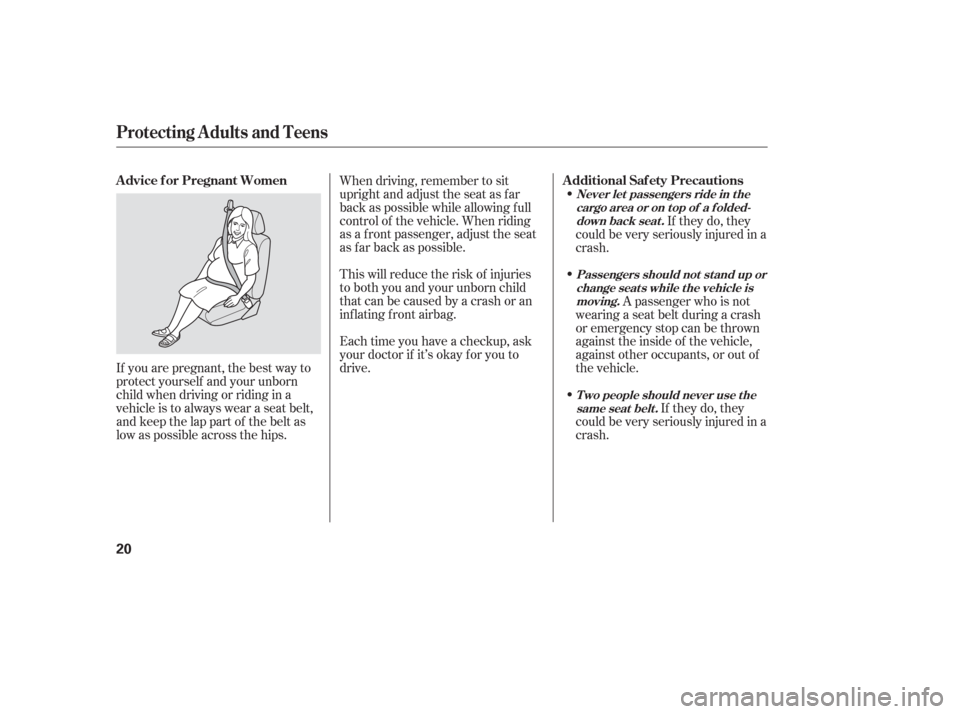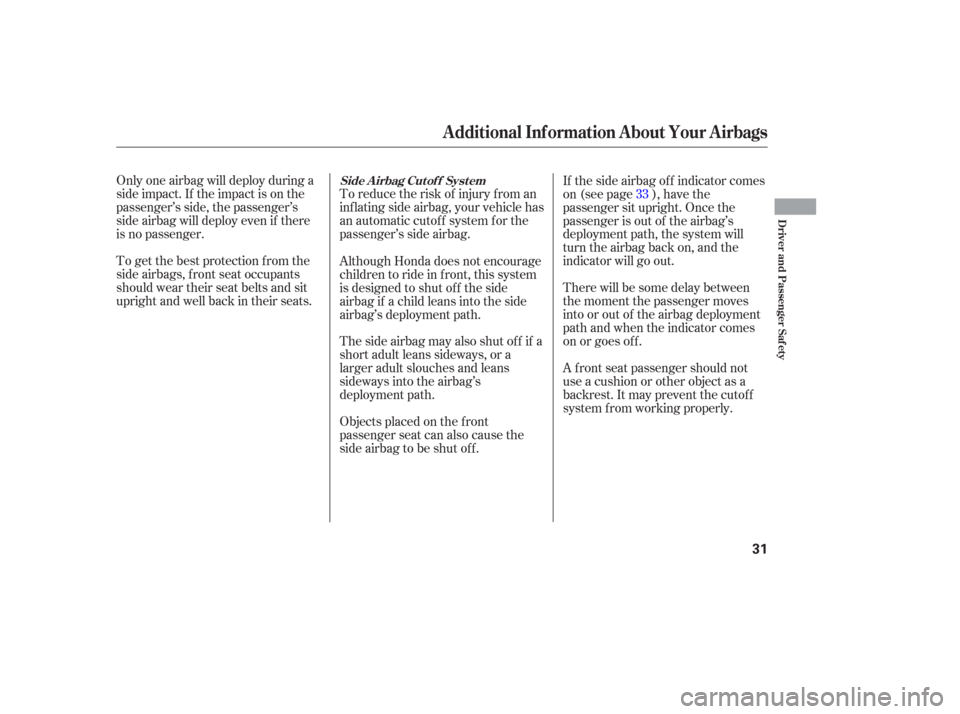Page 20 of 420
After all occupants have adjusted
their seats and put on seat belts, it is
very important that they continue to
sit upright, well back in their seats,
with their feet on the floor, until the
vehicle is parked and the engine is
off.
Sitting improperly can increase the
chance of injury during a crash. For
example, if an occupant slouches,
lies down, turns sideways, sits
forward, leans forward or sideways,
or puts one or both f eet up, the
chance of injury during a crash is
greatly increased.In addition, an occupant who is out of
position in the f ront seat can be
seriously or f atally injured in a crash
by striking interior parts of the
vehicle or being struck by an
inflating front airbag.
Protecting A dults and Teens
Maintain a Proper Sitting
Position
6.
Driver and Passenger Saf ety
19
Sitting improperly or out of
position can result in serious
injury or death in a crash.
Always sit upright, well back in
the seat, with your feet on the
floor.
Page 21 of 420

If you are pregnant, the best way to
protect yourself and your unborn
child when driving or riding in a
vehicle is to always wear a seat belt,
and keep the lap part of the belt as
low as possible across the hips.When driving, remember to sit
upright and adjust the seat as f ar
back as possible while allowing f ull
control of the vehicle. When riding
as a f ront passenger, adjust the seat
as far back as possible.
This will reduce the risk of injuries
to both you and your unborn child
that can be caused by a crash or an
inflating front airbag.
Each time you have a checkup, ask
your doctor if it’s okay f or you to
drive.
If they do, they
could be very seriously injured in a
crash.
A passenger who is not
wearing a seat belt during a crash
or emergency stop can be thrown
against the inside of the vehicle,
against other occupants, or out of
the vehicle.
If they do, they
could be very seriously injured in a
crash.
Protecting A dults and Teens
Advice f or Pregnant Women Additional Saf ety Precautions
Never let passengers ride in t he
cargo area or on t op of a f olded-down back seat .
Passengers should not stand up orchange seats while the vehicle ismoving.
T wo people should never use t hesame seat belt .
20
Page 26 of 420

Your Airbag System includes:Two SRS (supplemental restraint
system) f ront airbags. The driver’s
airbag is stored in the center of
the steering wheel; the f ront
passenger’sairbagisstoredinthe
dashboard. Both are marked ‘‘SRS
AIRBAG’’ (see page ).
Two side airbags, one f or the
driver and one f or a f ront
passenger. The airbags are stored
in the outer edges of the seat-
backs. Both are marked ‘‘SIDE
AIRBAG’’ (see page ).
Two side curtain airbags, one f or
each side of the vehicle. The
airbags are stored in the ceiling
above the side windows. All pillars
are marked ‘‘SIDE CURTAIN
AIRBAG’’ (see page ). 27
30
32
CONT INUED
A irbag System Components
Additional Inf ormation About Your Airbags
Driver and Passenger Saf ety
25
(3)
(4)
(1)
(8) (9)
(2)
(7) (5) (10)
(6)
(5) (4)
(11)(9)
(11) (12)
(13)
(1) Driver’s Front Airbag
(2) Passenger’s Front Airbag
(3) Control Unit
(4) Seat Belt Tensioners
(5) Side Airbags
(6) Side Curtain Airbag
(7) Driver’s Seat Position Sensor (8) Front Passenger’s Weight Sensors
(9) Front Impact Sensors
(10) Passenger Airbag Off Indicator
(11) Side Impact Sensors
(12) Occupant Position Detection
System (OPDS) Sensors
(13) Rollover Sensor
Page 27 of 420

A driver’s seat position sensor that
monitors the distance of the seat
from the front airbag. If the seat is
too f ar f orward, the airbag will
inf late with less f orce (see page).
Automatic seat belt tensioners
(see page ).
Sensors that can detect a
moderate to severe front impact or
side impact.
An indicator on the instrument
panel that alerts you to a possible
problem with your airbags (see
page ).Emergency backup power in case
your vehicle’s electrical system is
disconnected in a crash. An indicator on the dashboard that
alerts you that the passenger’s
f ront airbag has been turned of f
(see page ).
Sensors that can detect whether a
child is in the passenger’s side
airbag path and signal the control
unit to turn the airbag of f (see
page ). Weight sensors that monitor the
weight on the f ront passenger’s
seat. If the weight of an inf ant or
small child is detected, the
passenger’s f ront airbag will be
turned of f (see page ).
A rollover sensor that can detect if
your vehicle is about to roll over
and signal the control unit to
deploy both side curtain airbags
and f ront seat belt tensioners (see
page ).An indicator on the instrument
panel that alerts you that the
passenger’s side airbag has been
turned of f (see page ).
A sophisticated electronic system
that continually monitors and
records inf ormation about the
sensors, the control unit, the
airbag activators, the seat belt
tensioners, and driver and f ront
passenger seat belt use when the
ignition switch is in the ON (II)
position. 23
29
32 33
33 29
32 33
Additional Inf ormation About Your Airbags
26
Page 31 of 420

When the airbag is turned of f , an
indicator in the center of the
dashboard will come on indicating
passenger airbag ‘‘OFF’’ (see page).
If there is no passenger in the f ront
seat, the airbag will be off. However,
the Passenger Airbag Of f indicator
will not come on.
To ensure that the passenger’s
advanced front airbag system will
work properly,
This includes: A rear passenger pushing or
pulling on the back of the
passenger’s seat. Moving the f ront seat f orcibly
back against cargo on the seat or
f loor behind it.
Hanging heavy items on the f ront
passenger seat, or placing heavy
items in the seat-back pocket.
If you ever have a moderate to
severe side impact, sensors will
detect rapid acceleration and signal
the control unit to instantly inf late
either the driver’s or the passenger’s
side airbag and activate the seat belt
tensioner.
33
Additional Inf ormation About Your Airbags
How Your Side A irbags Work
do not do anyt hing
t hat would increase or decrease t he weight on the f ront passenger’s seat.
30
Page 32 of 420

Only one airbag will deploy during a
side impact. If the impact is on the
passenger’s side, the passenger’s
side airbag will deploy even if there
is no passenger.
To get the best protection f rom the
side airbags, front seat occupants
should wear their seat belts and sit
upright and well back in their seats.To reduce the risk of injury f rom an
inf lating side airbag, your vehicle has
an automatic cutoff system for the
passenger’s side airbag.
If the side airbag of f indicator comes
on (see page ), have the
passenger sit upright. Once the
passenger is out of the airbag’s
deployment path, the system will
turn the airbag back on, and the
indicator will go out.
There will be some delay between
the moment the passenger moves
into or out of the airbag deployment
pathandwhentheindicatorcomes
on or goes of f .
A f ront seat passenger should not
use a cushion or other object as a
backrest. It may prevent the cutof f
system f rom working properly.
Objects placed on the f ront
passenger seat can also cause the
side airbag to be shut of f . Thesideairbagmayalsoshutoff if a
short adult leans sideways, or a
larger adult slouches and leans
sideways into the airbag’s
deployment path. Although Honda does not encourage
children to ride in f ront, this system
is designed to shut of f the side
airbag if a child leans into the side
airbag’s deployment path. 33
Additional Inf ormation About Your Airbags
Side A irbag Cut of f Syst em
Driver and Passenger Saf ety
31
Page 33 of 420

If the impact is on the passenger’s
side, the passenger’s side curtain
airbag will inflate even if there are no
occupants on that side of the vehicle.When you turn the ignition switch to
the ON (II) position, this indicator
comes on brief ly then goes of f . This
tells you the system is working
properly.The SRS indicator alerts
you to a potential problem
with your airbags or seat belt
tensioners.
In a moderate to severe side impact,
sensors will detect rapid acceleration
and signal the control unit to
instantly inflate the side curtain
airbag and activate the seat belt
tensioner on the driver’s or the
passenger’s side of the vehicle. In a rollover toward the f ront
passenger’s side of the vehicle, both
side curtain airbags will inf late and
the f ront seat belt tensioners will
activate even if there are no
occupants on that side of the vehicle.
To get the best protection f rom the
side curtain airbags, occupants
should wear their seat belts and sit
upright and well back in their seats.
If the indicator comes on or
flashesonandoff whileyoudrive. If the indicator stays on after the
engine starts. If the SRS indicator does not come
on after you turn the ignition
switch to the ON (II) position.
If the indicator comes on at any
other time, or does not come on at all,
you should have the system checked
by your dealer. For example:
If the rollover sensor detects your
vehicle is about to roll over, the
control unit will instantly deploy both
side curtain airbags and activate the
f ront seat belt tensioners (see page
).
23
Additional Inf ormation About Your Airbags
In a Side Impact In a Rollover
How Your Side Curtain A irbags
Work
How the SRS Indicator Works
32
Page 35 of 420

Even if your
airbags do not inflate, your dealer
should inspect the driver’s seat
position sensor and the f ront
passenger’s weight sensors to
make sure they are operating
properly.
Any airbag
that has deployed must be
replaced along with the control
unit and other related parts. If a
f ront airbag inf lates, the seat belt
tensioners must also be replaced.
Do not try to remove or replace
anyairbagbyyourself.Thismust
be done by your dealer or a
knowledgeable body shop.
Take your vehicle to an
authorized dealer as soon as
possible. If you ignore this
indication, your airbags may not
operate properly.
Your airbag systems are virtually
maintenance f ree, and there are no
parts you can saf ely service.
However, you must have your
vehicle serviced if:
If no one is riding in the f ront seat,
the airbag will be automatically shut
of f . However, the indicator will not
come on.
If the indicator comes on with no
passenger in the f ront, or with an
adult in the seat, there may be a
problem with the advanced airbag
system. Have the vehicle checked by
the dealer as soon as possible.
The passenger airbag of f indicator
may also come on and of f repeatedly
if total weight on the seat is near the
airbag cutoff threshold.
If this happens, have the passenger
ride properly restrained in a back
seat. If the passenger must ride in
front, move the seat as far to the
rear as possible, and have the
passenger sit upright and wear the
seat belt properly.
Additional Inf ormation About Your Airbags
If your vehicle has a moderat e t o
severe impact .
An airbag ever inf lates.
T he SRS indicat or alert s you t o aproblem.Airbag Service
34